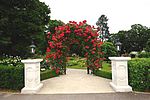-

Störche
The "royal free city" of Rust - the town of the storks and fine wines - borders on Lake Neusiedl to the east and the hill country of Rust to the west. The heart of the hill country of Rust is made up of crystalline basement complex surrounded by "Leithakalk" (limestone), sand-lime brick and unconsolidated sediments. There are still some traditional pastures on the slopes of the hill country of Rust, which boast a variety of flora and fauna with species on the "red list" (European Red List of Globally Threatened Animals and Plants - ECE) like the Adonis vernalis, large and black Pasque flowers and the dwarf iris.
The diversity and strongly structured vegetation provides perfect living conditions for the mantis, butterflies, European green lizard, European group squirrel and the hoopoe.
Lake Neusiedl bordering on the east with its up to 5 km wide reed belt and the adjoining damp meadows were created approx. 20,000 years ago by tectonic breaks and shifts.This area is especially home to a wide variety of fauna such as, for example, small crustaceans, fish (tench, roach, wild carp, pike, pike-perch or weather loach), water snails, frogs, fire-bellied toads, water shrews, musk rats, great white egrets, purple herons and grey herons, Eurasian spoonbills, Eurasian reed warblers and great reed warblers, great bitterns, little and great-crested grebes, pochards, Eurasian coots, grey gees and Western marsh harriers.
And the white stork, which is so characteristic of the "royal free city" of Rust, also makes use of the rich food availability on the damp meadows. Cattle graze on these damp meadows in order to ensure their preservation - this also prevents the reeds from advancing into these damp meadow areas. The forests have been reducted to small groups of trees due to the intensification of viticulture. In 1996 Rust decided to reforest former wooded areas. Vineyards were cleared and replanted with common oaks, smooth-leaved elms, hornbeams, acorns, large-leaf lindens, wild fruit trees, service trees, cornelian cherry trees, whitebeams, hawthorns, blackthorns and privets in copperation with the Province of Burgenland and the Austrian Federal Forest Research Centre (FBVA) in Vienna.

A national park is an instrument used worldwide to preserve unique landscapes and habitats for rare, characteristic and endangered animal and plant species in the long term.
Kontact: Informationszentrum Nationalpark Neusiedler See - Seewinkel Hauswiese, A-7142 Illmitz
Tel.: +43 (0) 2175 / 3442

The carefully arranged rose garden contains 1600 roses in 300 varieties on 4000 m². The stage is located in the heart of the Rosentheater, with the "Duftrosenweg für Sehbehinderte", a unique venue in Austria.
Kontakt: Kurpark (Hauptplatz), A-7202 Bad Sauerbrunn
Tel: +43 (0) 699 / 181 737 35

Felsenmuseum (ca. 86 Km von Rust entfernt)
Go into the underground world of the Bernstein Rock Museum and see everything interesting about the extraction and processing of precious serpentine, the mining history of the town and its surroundings and much more
Fam. Potsch, Hauptplatz 5, A-7434 Bernstein
Tel: +43 (0) 3354 / 6620
Opening hours: March – December open daily